2021 MERCEDES-BENZ GLE COUPE wheel
[x] Cancel search: wheelPage 322 of 466
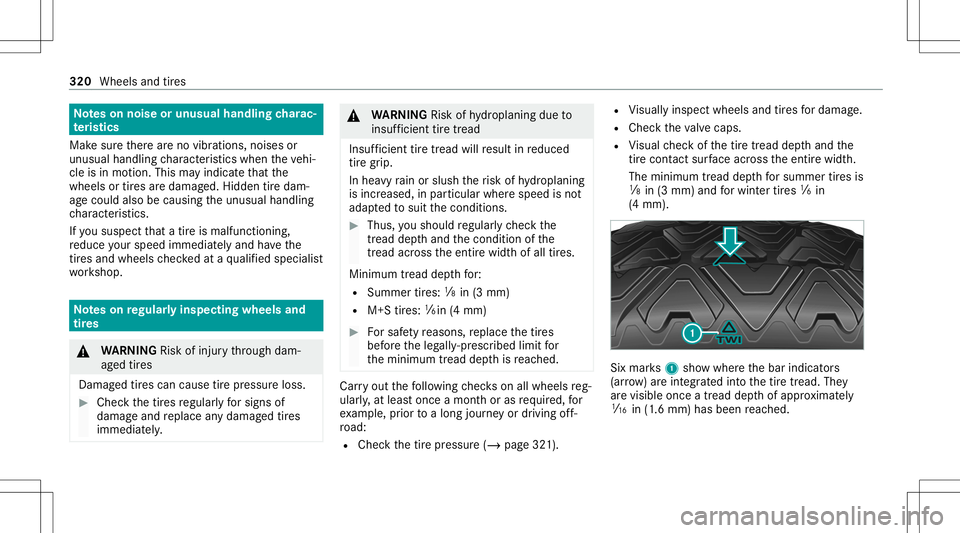
No
teson noise orunusua lhand lingcharac‐
te rist ics
Mak esur eth er ear eno vibr ations, noisesor
unusual handling charact eristic swhen theve hi‐
cle isin mo tion. Thismayindicat eth at the
wheels ortires aredamag ed.Hidde ntir edam‐
ag ecould alsobecausin gth eunusual handling
ch aract eristic s.
If yo ususp ectthat atir eis malf unctionin g,
re duce your spee dimm ediat elyand have the
tir es and wheelsch eckedat aqu alif ied spec ialist
wo rkshop. No
teson regular lyinspect ingwheels and
tir es &
WARNIN GRisk ofinju rythro ugh dam‐
ag ed tires
Dam aged tires can caus etir epr ess ureloss . #
Chec kth etir es regular lyforsigns of
dama geand replace anydamag edtires
immediat ely. &
WARNIN GRisk ofhydroplaning dueto
insuf ficie nttiretrea d
Insu fficien ttir etread willresult inreduced
tir egr ip.
In hea vyrain or slush therisk ofhydroplaning
is incr eased, inpar ticular wherespeed isno t
adap tedto suit thecon ditions . #
Thus, yousho uld regular lych eckth e
tr ea dde pthand thecon dition ofthe
tr ea dacr oss theent ire widt hof all tires.
Minimum tread depthfor:
R Summ ertires: 00CEin(3 mm)
R M+S tires: 00CFin (4mm) #
Forsaf etyre ason s,replace thetir es
bef oreth eleg ally -prescr ibed limit for
th eminimum tread depthisreac hed. Car
ryout thefo llo wing checks on allwheels reg‐
ular ly,at leas tonce amont hor as requ ired, for
ex am ple, prior toalon gjo ur ne yor drivin gof f-
ro ad:
R Chec kth etir epr essur e(/ page32 1). R
Visual lyinspect wheelsandtires fordama ge.
R Chec kth eva lve caps.
R Visual checkof thetir etread depthand the
tire cont actsurface across theent ire widt h.
The minimum tread depthforsummer tires is
00CE in(3 mm) andforwint ertires 00CF in
(4 mm). Six
mar ks1 showwher eth ebar indicat ors
(ar row )ar eint egr ated intoth etir etread. They
ar evisible onceatread depthofappr oximat ely
00CD in(1.6 mm) hasbeen reac hed. 320
Wheelsand tires
Page 323 of 466
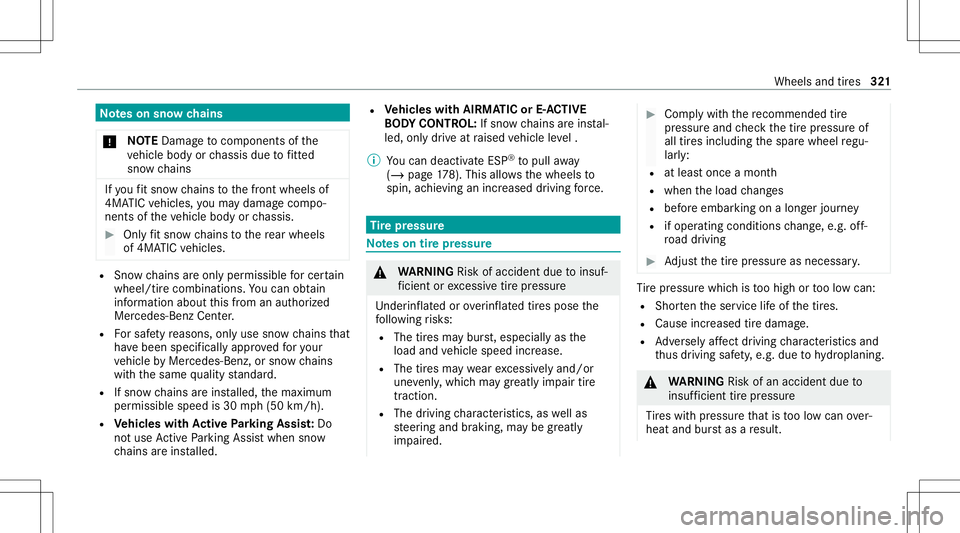
No
teson sno wch ains
* NO
TEDama getocom pone ntsofthe
ve hicle body orchassis duetofitt ed
sno wch ains If
yo ufit sno wch ains tothefront wheels of
4MA TICvehicles, youma ydamag eco mp o‐
nent sof theve hicle body orchassis . #
Onlyfit sno wch ains tothere ar wheels
of 4MA TICvehicles. R
Sno wch ains areon lype rm issible forcer tain
wheel/t ire com binat ions.Yo ucan obtain
inf ormat ionabout this from anaut hor ized
Mer cedes -Benz Cent er.
R Forsaf etyre ason s,on lyuse snow chains that
ha ve been specif icallyapproved foryo ur
ve hicle byMer cedes-Ben z,or sno wch ains
wit hth esame qualit yst andar d.
R Ifsn ow chains areins talled, themaximum
per missible speedis30 mph(50 km/h).
R Vehicl eswith Activ ePa rking Assis t:Do
no tuse ActivePa rking Assistwhen snow
ch ains areins talled. R
Vehicl eswith AIRMA TICorE-AC TIVE
BO DY CONT ROL:Ifsn ow chains areins tal‐
led, onlydr ive at raised vehicle leve l.
% Youcan deac tivateES P®
to pull away
( / pag e17 8). This allo ws thewheels to
spin, achie ving anincr eased driving forc e. Ti
re pres sur e No
teson tirepr essur e &
WARNIN GRisk ofacci dent dueto insuf ‐
fi cie ntor excess ive tir epr ess ure
Under inflate dor ove rinf late dtir es pose the
fo llo wing risk s:
R The tires ma ybur st,especiall yas the
load andvehicle speed increase.
R The tires ma ywe arexc essiv elyand/or
une venly, whic hma ygr ea tly impair tire
traction .
R The drivin gch aract eristic s,as wellas
st eer ing and braking, maybe greatl y
im pair ed. #
Com plywithth ere comme ndedtire
pr ess ureand checkth etir epr essur eof
all tires including thespar ewheel regu‐
lar ly:
R atleas tonce amont h
R when theload chang es
R beforeembar kingon alon gerjour ney
R ifoper ating conditions chang e,e.g .of f-
ro ad drivin g #
Adjus tth etir epr essur eas neces sary. Ti
re pressur ewhic his toohigh ortoolow can:
R Shor tenth eser vice life of thetir es.
R Cause increased tiredamag e.
R Adversely affect drivi ng charact eristic sand
th us drivin gsaf ety, e.g. due tohydroplaning. &
WARNIN GRisk ofan acci dent dueto
insuf ficie nttirepr ess ure
Ti re swit hpr essur eth at istoolow can over‐
heat andburstas are sult. Wheels
andtires 32
1
Page 324 of 466
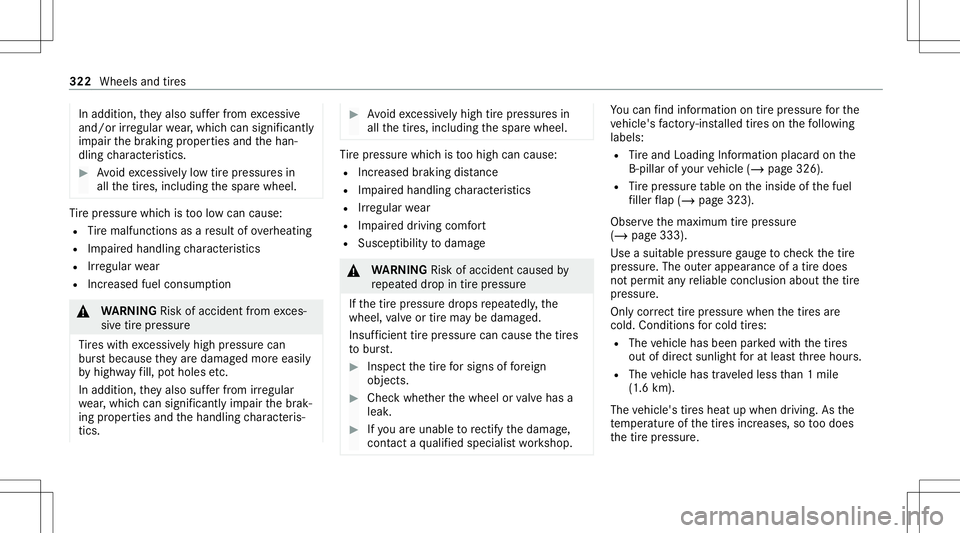
In
addi tion, they also sufferfr om excess ive
and /or irre gular wear,whic hcan significan tly
im pair thebr aking proper tiesand thehan‐
dling charact eristic s. #
Avoid excessiv elylow tirepr essur esin
all thetir es, including thespar ewheel. Ti
re pressur ewhic his toolow can cause:
R Tire malfu nctions asare sult ofove rheating
R Impair edhandling charact eristic s
R Irre gular wear
R Incr eased fuelconsum ption &
WARNIN GRisk ofacci dent from exces‐
siv etir epr ess ure
Ti re swit hexc essiv elyhigh pressur ecan
bur stbecause they aredamag edmor eeasil y
by highw ayfill, po tholes etc.
In addition, they also sufferfr om irre gular
we ar,whic hcan significan tly im pair thebr ak‐
ing proper tiesand thehandling charact eris‐
tic s. #
Avoid excessiv elyhigh tirepr essur esin
all thetir es, including thespar ewheel. Ti
re pressur ewhic his toohigh cancause:
R Increased brakin gdis tance
R Impaired handl ing charact eristic s
R Irre gular wear
R Impair eddrivin gcom fort
R Sus ceptibility to damag e &
WARNIN GRisk ofacci dent caused by
re peat eddrop intirepr essur e
If th etir epr essur edr ops repeat edly,th e
wheel, valve or tirema ybe damag ed.
Insuf ficie nttirepr ess urecan causethetir es
to bur st. #
Inspect thetir efo rsigns offore ign
obje cts. #
Chec kwhe ther thewheel orvalve has a
leak . #
Ifyo uar eunab leto rectify thedamag e,
con tact aqu alif ied spec ialistwo rkshop. Yo
ucan find informa tionon tirepr ess urefo rth e
ve hicle's fact or y-ins talled tires on thefo llo wing
labels:
R Tire and Loadi ngInfo rm atio nplacar don the
B‑pil larof your vehicle (/page326).
R Tire pressur eta ble ontheinside ofthefuel
fi ller flap (/ page32 3).
Obse rveth emaximum tirepr essur e
(/ page333).
Use asuit able pressur ega ug eto checkth etir e
pr essur e.The outerappear anceofatir edoes
no tper mit anyre liable conclusion aboutthetir e
pr essur e.
Onl ycor rect tirepr ess urewhe nth etir es are
cold. Condition sfo rcold tires:
R The vehicle hasbeen parkedwit hth etir es
out ofdir ect sunlight forat lea stthre ehour s.
R The vehicle hastrave led less than 1mile
(1 .6 km ).
The vehicle's tires heat upwhen driving. Asthe
te mp eratur eof thetir es incr eases, sotoodoes
th etir epr essur e. 322
Wheels andtires
Page 326 of 466
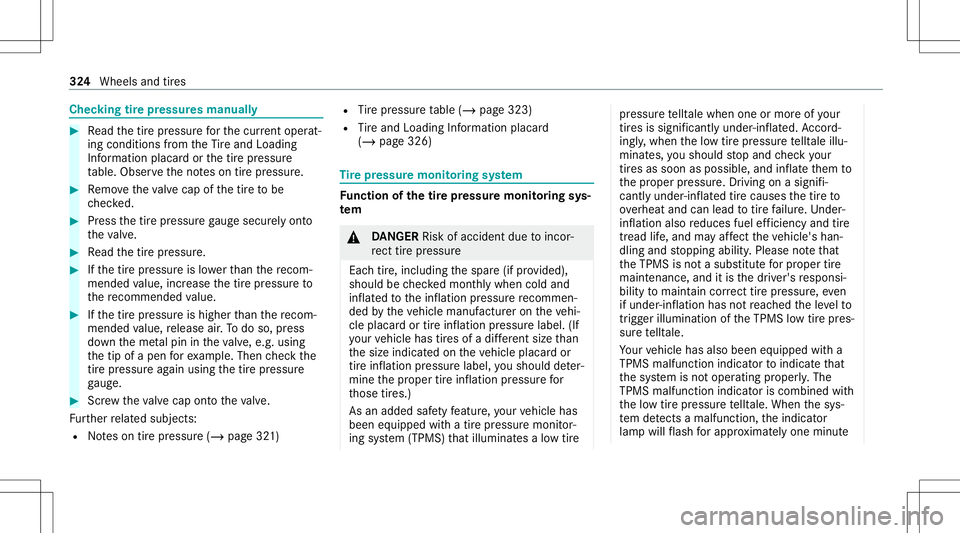
Chec
kingtirepr essu resmanu ally #
Read thetir epr essur efo rth ecur rent operat‐
ing cond itions from theTire and Loadi ng
In fo rm atio nplacar dor thetir epr essur e
ta ble. Obser vetheno teson tirepr essur e. #
Remo vetheva lve cap ofthetir eto be
ch ecked. #
Press thetir epr essur ega ug esec urelyon to
th eva lve. #
Read thetir epr essur e. #
Ifth etir epr essur eis lowe rth an there com‐
mend edvalue, increase thetir epr essur eto
th ere comme ndedvalue. #
Ifth etir epr essur eis higher than there com‐
mend edvalue, release air.To do so, press
do wn theme talpin intheva lve, e.g. using
th etip ofapen forex am ple. Then checkth e
tir epr es su re again usin gth etir epr essur e
ga ug e. #
Screw theva lve cap ontoth eva lve.
Fu rther relat ed subje cts:
R Noteson tirepr essur e(/ page32 1) R
Tire pressur eta ble (/ page323 )
R Tire and Loadi ngInfo rm atio nplacar d
(/ page32 6) Ti
re pres sur emoni toring system Fu
nction ofthetir epr essur emoni toring sys‐
te m &
DANG ER Risk ofacc iden tdue toinc or‐
re ct tirepr ess ure
Eac htir e, incl uding thespar e(if prov ided),
should becheckedmont hlywhen coldand
inf lated totheinf lation pressur ere comme n‐
ded bytheve hicle manuf actureron theve hi‐
cle placar dor tireinf lation pressur elabel .(If
yo ur vehicle hastires ofadif fere nt size than
th esize indicat edon theve hicle placar dor
tir einf lation pressur elabel ,yo usho uld deter‐
mine thepr oper tireinf lation pressur efo r
th ose tires.)
As anadded safetyfe atur e,your vehicle has
been equipped withatir epr essur emonit or‐
ing system (TPMS) that illumin ates alow tire pr
essur ete lltale when oneormor eof your
tir es issign ifican tly und er-in flat ed. Accor d‐
ing ly,whe nth elow tirepr essur ete lltale illu‐
min ates, yousho uld stop and checkyo ur
tir es assoo nas poss ible, andinflateth em to
th epr oper pressur e.Driving onasignif i‐
cant lyunder -inflated tirecauses thetir eto
ove rheat and canlead totirefa ilur e.Un der -
inf lation alsoreduces fuelefficie ncy and tire
tr ea dlife ,and mayaf fect theve hicle's han‐
dling andstopping ability.Please note that
th eTPMS isno ta subs titutefo rpr oper tire
maint enance, anditis thedr iver's responsi‐
bility tomaint aincorrect tirepr ess ure, eve n
if under -inflatio nhas notre ac hed theleve lto
tr ig ge rill umina tionoftheTPMS low tirepr es‐
sur ete lltale.
Yo ur vehicle hasalso been equipped witha
TPMS malfunction indicatortoindic ateth at
th esy stem isno toper ating proper ly.The
TPMS malfunct ionindicat oriscombin edwith
th elow tirepr essur ete lltale. When thesy s‐
te m detects amal functi on,theindicat or
lam pwill flash forapp roxima tely one minu te 32
4
Wheels andtires
Page 327 of 466

and
then remain continuously illumina ted.
This sequence willcontinue upon subseq uent
ve hicle star t-ups aslon gas themalfunct ion
ex ists.
When themalfunct ionindicat orisillumina‐
te d, thesy stem mayno tbe able todetect or
sig nal low tirepr ess ureas intende d.TPM S
mal functi onsmayoccu rfo ra va riet yof rea‐
son s,inc ludin gth eins tallation ofreplace‐
ment oralternat etir es orwheels ontheve hi‐
cle that prev ent theTPMS from func tioning
pr oper ly.
Alw aysch eckth eTPMS malfunct iontelltale
af te rre placing oneormor etir es orwheels
on your vehicle toensur eth at there place‐
ment oralternat etir es and wheels allowthe
TPMS tocontinu eto function proper ly. The
system checks thetir epr essur eand thetir e
te mp eratur eof thetir es installed totheve hicle
by means ofatir epr essu resensor .
The tirepr essur eand thetir ete mp eratur e
appear inthemultifunc tiondispla y
(/ page325). If
th er eis asubs tantia lpr ess ureloss orifth e
tir ete mp eratur eis exc essiv e,youwill bewarned
in thefo llo wing ways:
R viadisp lay messa ges(/ page41 2)
R viathe0077 warning lam pin theins trument
clus ter
The tirepr essur emonit oring system isonl yan
aid. Itis thedr iver's responsibili tyto setth etir e
pr essur eto there comme ndedcoldtirepr ess ure
su itab leforth eoper ating situation .
In mos tcases, thetir epr essur emonit oring sys‐
te m wil lau tomatical lyupdat eth ene wrefere nce
va lues afte ryo uha ve chang edthetir epr essur e.
Yo ucan ,ho we ver,also updat eth ere fere nce val‐
ues byrestar tin gth etir epr essur emonit oring
sy stem manually (/page326).
Sy stem limit s
The system maybe impair edorma yno tfunc tion
in thefo llo wing situat ions:
R thetir epr essur ehas been setincor rectl y
R ther eis asudden pressur eloss caused, for
ex am ple, byafo re ign obje ctpene tratin gth e
tir e R
ther eis amalfunct ioncaused byano ther
ra dio signal source
Chec kingthetir epr essur ewit hth etir epr es‐
sur emoni toring system
Re quirement s:
R The ignit ionisswitc hedon.
On- boar dcom puter:
4 Service 5
Tires
One ofthefo llo wing displa ysappear s:
R Cur rent tirepr ess ureand tirete mp eratur eof
th eindividual wheels: Wheels
andtires 325
Page 328 of 466
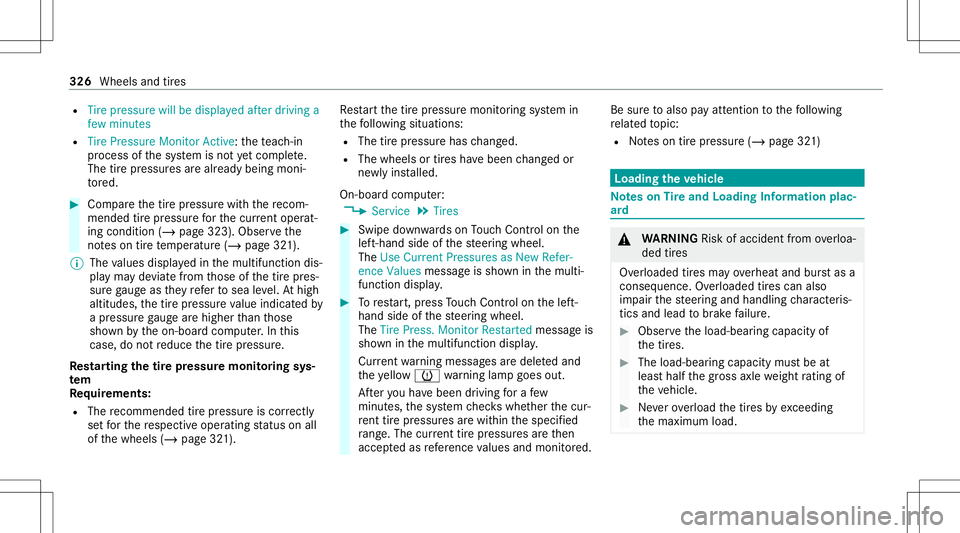
R
Tire pressure willbedisplay edafter driving a
few minutes
R Tire Pressure MonitorActive: thete ac h-in
pr oce ssofthesy stem isno tye tcomple te.
The tirepr essur esarealr eady being moni‐
to re d. #
Com pareth etir epr essur ewit hth ere com‐
mend edtirepr ess urefo rth ecur rent operat‐
ing cond ition (/ page 323). Observeth e
no teson tirete mp eratur e(/ page32 1).
% The values displa yedin themultifunc tiondis‐
pla yma yde viat efrom those ofthetir epr es‐
sur ega ug eas they referto sea leve l.At high
altitudes, thetir epr essur eva lue indic ated by
a pr essur ega ug ear ehigh erthan those
sho wnbytheon- boar dcom puter.In this
case, donotre duce thetir epr essur e.
Re star ting thetir epr essur emoni toring sys‐
te m
Re quirement s:
R The recomme ndedtirepr ess ureis cor rectl y
se tfo rth ere spectiv eoper ating status onall
of thewheels (/page32 1). Re
star tth etir epr essur emonit oring system in
th efo llo wing situat ions:
R The tirepr essur ehas chang ed.
R The wheels ortires have been chang edor
ne wlyins talled.
On- boar dcom puter:
4 Service 5
Tires #
Swipe down wardson Touc hCon trol on the
lef t-hand sideofthesteer ing wheel.
The Use Current Pressures asNew Refer-
ence Values messag eis sho wninthemulti‐
func tion displa y. #
Torestar t,pr ess Touc hCon trol on thelef t-
hand sideofthesteer ing wheel.
The Tire Press. MonitorRestart edmessag eis
sho wninthemultifunc tiondispla y.
Cur rent wa rning mess ages aredele tedand
th eye llo w0077 warning lam pgoes out.
Af teryo uha ve been driving fora fe w
minut es,thesy stem checks whe ther thecur‐
re nt tirepr ess ures arewi thin thespecif ied
ra ng e. The current tirepr ess ures areth en
accep tedas refere nce values andmon itor ed. Be
sureto also payatt ent ion tothefo llo wing
re lat ed topic:
R Noteson tirepr essur e(/ page32 1) Loading
theve hicl e No
teson Tire and Loading Information plac‐
ar d &
WARNIN GRisk ofacci dent from overloa‐
ded tires
Ov erloaded tires ma yove rheat and burstas a
con sequenc e.Ov erloaded tires can also
im pair thesteer ing and handling charact eris‐
tic sand lead tobrak efa ilur e. #
Obser vetheload-bear ingcapacity of
th etir es. #
The load-bear ingcapacity mustbe at
leas thalf thegr oss axle weight rating of
th eve hicle. #
Neverove rload thetir es by exc eeding
th emaximum load. 326
Wheels andtires
Page 330 of 466
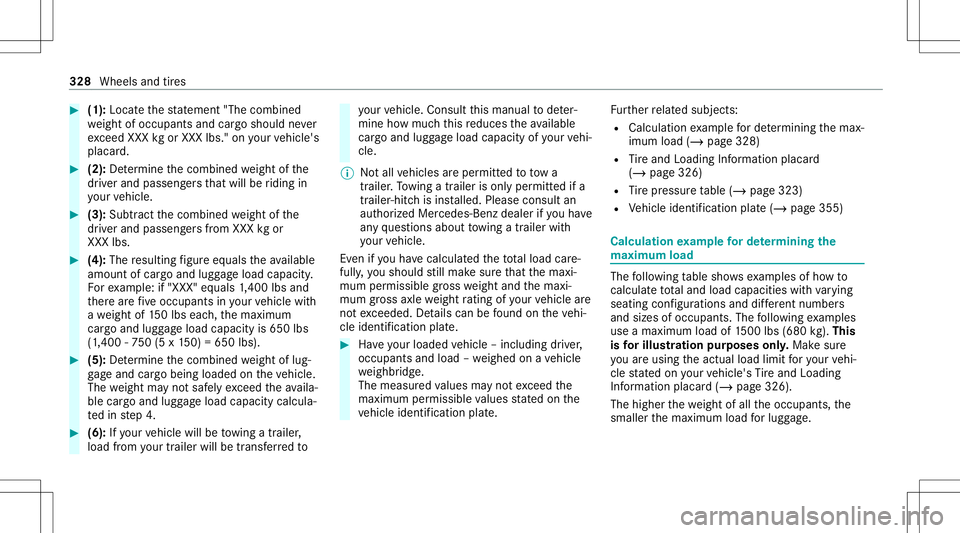
#
(1): Locateth est at emen t"The combined
we ight ofocc upant sand cargoshould never
exc eed XXX kgorXXX lbs." onyour vehicle's
placar d. #
(2): Determ ine thecombin edweight ofthe
dr iver and passeng ersth at will beriding in
yo ur vehicle. #
(3): Subtr actthecombin edweight ofthe
dr iver and passeng ersfrom XXX kgor
XXX lbs. #
(4): The resulting figur eeq uals theav ailable
amoun tof car goand luggageload capac ity.
Fo rex am ple: if"XXX "eq uals 1,400 lbsand
th er ear efive occupant sin your vehicle with
a we ight of150lbs eac h,themaximum
car goand luggageload capacity is650 lbs
(1 ,400 -75 0(5 x15 0) =650 lbs). #
(5):De term ine thecombin edweight oflug‐
ga ge and cargobein gloaded ontheve hicle.
The weight mayno tsaf elyexc eed theav aila‐
ble cargoand luggageload capac itycalc ula‐
te din step 4. #
(6): Ifyo ur vehicle willbetowing atrailer ,
load from your trailer willbetrans ferred to yo
ur vehicle. Consult this manual todeter‐
mine howmuc hth is reduces theav ailable
car goand luggageload capac ityofyour vehi‐
cle.
% Notall vehicles areper mitt edtotow a
trailer .To wing atrailer isonl yper mittedifa
tra iler -hit chisins talled. Please consult an
aut hor ized Mercedes -Benz dealer ifyo uha ve
an yqu estion sabout towing atrailer with
yo ur vehicle.
Ev en ifyo uha ve cal cul ated thetot alload care‐
full y,yo usho uld still mak esur eth at themaxi‐
mum permissible gross weight andthemaxi‐
mum gross axle weight rating ofyour vehicle are
no texc eeded. Details can befound ontheve hi‐
cle identif ication plate. #
Have your loaded vehicle –including driver ,
occupants andload –we ighed onave hicle
we ighbr idge.
The measur edvalues mayno texc eed the
maximu mper missi blevalues stat ed on the
ve hicle identif ication plate. Fu
rther relat ed subje cts:
R Calculation exam ple forde term inin gth emax‐
imum load(/page328)
R Tire and Loadi ngInfo rm atio nplacar d
(/ page32 6)
R Tire pressur eta ble (/ page323 )
R Vehicle identif ication plate(/ page355) Calculation
exam ple forde term ining the
ma ximum load The
follo wing table showsexam ples ofhowto
cal cul ateto ta land load capac itieswithva rying
seatin gcon figur ations anddiffere nt num bers
and sizes ofocc upant s.The follo wing exam ples
use amax imum loadof1500 lbs (680 kg).This
is forillus tratio npur pos esonly.Mak esur e
yo uar eusin gth eactual loadlimit foryo ur vehi‐
cle stat ed on your vehicle's Tire and Loadi ng
In fo rm atio nplacar d(/ page32 6).
The high erthewe ight ofall theoccupant s,the
smaller themaximum loadforlug gage . 328
Wheels andtires
Page 331 of 466
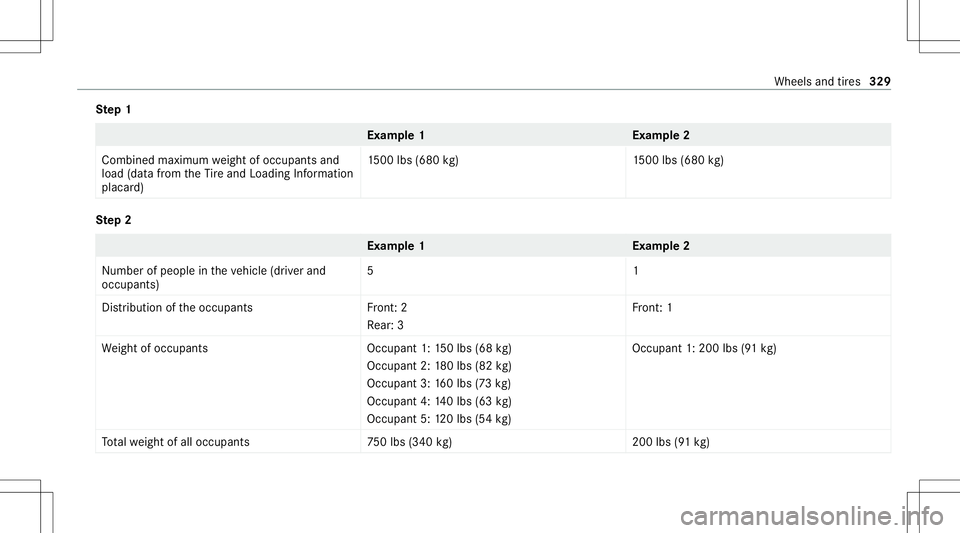
Ste
p1 Ex
am ple 1E xamp le2
Combine dmaxim umweight ofocc upant sand
load (datafrom theTire and Loadi ngInfo rm atio n
placar d) 15
00 lbs (680 kg)1 500lbs(680 kg) Ste
p2 Ex
am ple 1E xamp le2
Nu mb erofpeople intheve hicle (driver and
occupants) 51
Dis trib uti on oftheoccupant sF ront:2
Re ar:3 Fr
ont :1
We ight ofocc upant sO ccupant1:150lbs (68 kg)
Occupant 2:180lbs (82 kg)
Occupant 3:160lbs (73 kg )
Occupant 4:140lbs (63 kg)
Occupant 5:120lbs (54kg ) Occupant
1:200 lbs(91 kg )
To talwe ight ofall occ upant s7 50lbs (340 kg)2 00lbs (91 kg ) Wheels
andtires 329